#ada accessibility
Explore tagged Tumblr posts
Text
Hey OP, if you live in an American city there is a good chance that your sidewalks are owned and maintained by your city/county government. Try adding your local council member and maybe the local engineering/public works department into those emails
Today I had the spoons to hunt down my neighborhood council's email and send them an email that basically said "I would like to be able to leave my house but my neighborhood is not wheelchair accessible. Who do I talk to in order to get this fixed?" And I am planning on hunting down whoever is in charge of sidewalks in my neighborhood and getting real annoying about it.
My plan is to email them every time I want to go somewhere but can't.
Email 1: hello, please fix sidewalks so I can ride the bus places I am very passionate about public transportation and also being able to leave my house.
Email 200: This morning I woke up and wanted some delicious coffee to start my day, but upon getting out of bed I discovered we were out of coffee. I would've liked to take advantage of the city's public transportation system in order to support a local business like [examples of local coffee shops] but alas I cannot because I am a wheelchair user and my neighborhood is not wheelchair accessible. [Insert rest of arguement RE accessibility]. In conclusion I don't work I can keep these emails coming until I die please just fix my sidewalks.
This is going to be my new spite hobby. I was already mad about the abuse and general shit hand the disabled get dealt in our culture but then I started using a wheelchair and places like doctor's offices have been inaccessible to me so now I am filled with rage. So I am going to take that rage and do something with it. Like emailing my city counsel representatives at 2 am like "I crave a moonlight walk fix my sidewalks please."
#Sidewalks#Ada accessibility#Seriously#I had a summer job surveying which sidewalks had to be replaced for a city government#and so many elderly and disbabled people were THRILLED to know that we were even looking into repairing said sidewalks!#May not apply if in a gated community though.
36K notes
·
View notes
Text
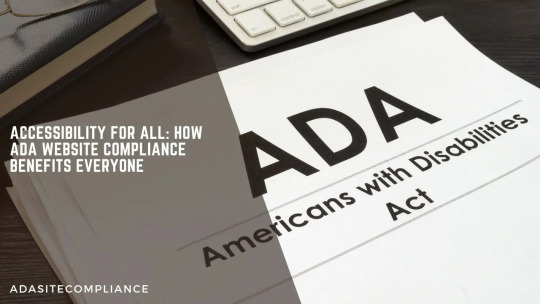
Accessible Websites
Design websites with features and functionalities that enable individuals with disabilities to access and interact with online content effectively, promoting a more inclusive and equitable digital experience!
#ADA Website Compliance Benefits#ADA Compliance#ADA Accessibility#Americans with Disabilities Act (ADA)#Web Accessibility#ADA Website Benefits#Web Content Accessibility Guidelines (WCAG)#ADA Compliant Websites#Accessibility Standards#Accessible Websites#Digital Accessibility#Free Website Scan#ada site compliance#web accessibility#accessibility services#diversity and inclusion#ada guidelines#inclusive design#accessible website development#ada compliance solutions#web accessibility audit#digital accessibility#equitable web design#ada regulations#inclusive user experience#ada consulting#accessible content#ada accessibility#web design for disabilities#disability compliance
0 notes
Text
A Comprehensive Guide to ADA Website Accessibility Guidelines
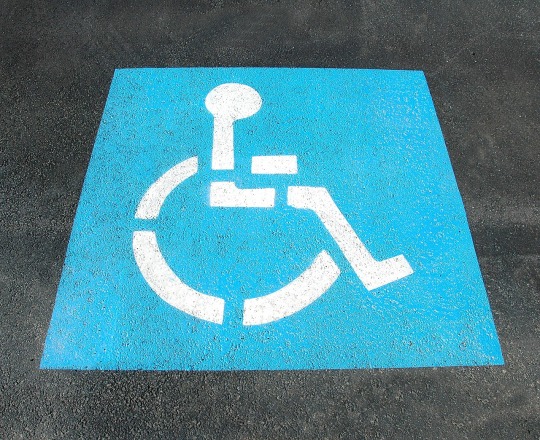
In the ever-evolving digital landscape, creating an inclusive online environment is not just a choice; it's a responsibility. ADA (Americans with Disabilities Act) website accessibility guidelines play a pivotal role in ensuring that websites are accessible to everyone, regardless of their abilities or disabilities. In this comprehensive guide, we'll delve into the key aspects of ADA website accessibility guidelines, shedding light on why they matter and how you can implement them to enhance user experience and reach a broader audience.
1. Understanding ADA Website Accessibility Guidelines:
ADA website accessibility guidelines are a set of standards designed to make digital content accessible to individuals with disabilities. These guidelines cover a wide range of aspects, including but not limited to, web design, development, and content creation. The primary goal is to break down barriers and provide equal access to information and services for everyone.
2. The Importance of ADA Compliance:
Achieving ADA compliance isn't just about following regulations; it's about creating an inclusive online space. Non-compliance not only risks legal consequences but also excludes a significant portion of the population from accessing your website. By adhering to ADA guidelines, you not only meet legal requirements but also demonstrate a commitment to inclusivity, fostering a positive brand image.
3. Key Components of ADA Website Accessibility
Content Accessibility: Ensure that your website content is perceivable, operable, and understandable for all users. This includes providing text alternatives for non-text content, making multimedia content accessible, and ensuring readability.
Navigation and Structure: Create a clear and intuitive navigation structure. Proper heading structures, labels, and navigation menus contribute to a seamless browsing experience for users with screen readers or other assistive technologies.
Color and Contrast: Pay attention to color choices and contrast ratios to accommodate users with visual impairments. Make sure that information is conveyed effectively, regardless of the user's ability to perceive certain colors.
Forms and Interactive Elements: Design forms and interactive elements with accessibility in mind. Provide clear instructions, use labels correctly, and ensure that all form fields are easily navigable and operable.
4. Testing and Evaluation
Regular testing is crucial to ensuring ongoing ADA compliance. Conduct regular audits and usability tests, seeking feedback from individuals with disabilities. This iterative process helps identify and address accessibility issues promptly.
5. Implementing ADA Compliance in Web Development:
Accessible Coding Practices: Adopt coding practices that prioritize accessibility. This includes using semantic HTML, providing alternative text for images, and ensuring proper document structure.
Responsive Design: Create a responsive design that adapts to various devices and screen sizes. This not only benefits users with disabilities but also improves overall user experience.
6. Staying Updated with Evolving Standards: The digital landscape and accessibility standards are continually evolving. Stay informed about updates to ADA guidelines and other relevant standards to ensure ongoing compliance and optimal user experience.
Conclusion
Embracing ADA website accessibility guidelines is a step towards creating a more inclusive digital space. By prioritizing accessibility, you not only comply with legal requirements but also contribute to a more diverse and user-friendly online environment. Implementing these guidelines fosters a culture of inclusivity, making your website a welcoming space for all users, regardless of their abilities.
1 note
·
View note
Text
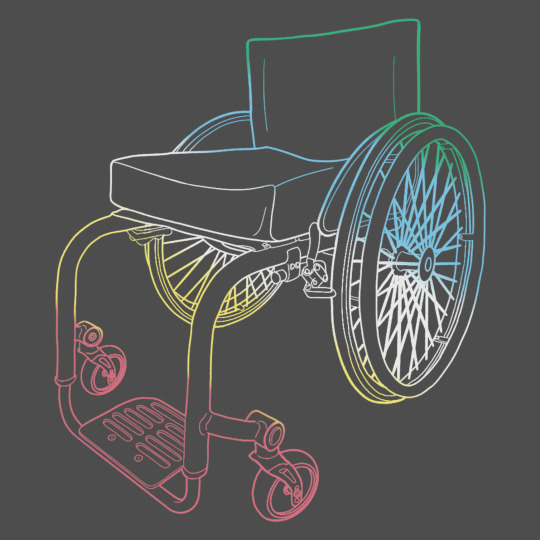
A drawing of my wheelchair for disability pride month!
(ID: on a medium grey background is a line art drawing of an ultra-lightweight wheelchair, specifically a Tilite Aero Z chair. The line art is colored in a gradient in stripes to mimic the disability pride flag. The colors from the lower left to the upper right are: a muted red, yellow, white, sky blue and a hunter green. End ID)
#chronically couchbound#disability#disabled#cripplepunk#cripple punk#disabled pride#disability pride#disabled pride month#happy disability pride month#disability pride month#my art#digital art#disabled artist#disability pride flag#crip rights#cripple pride#queer cripple#cripple#cpunk#crip punk#wheelchair#wheelchair art#wheelchair user#wheelchairs#ada accessible
2K notes
·
View notes
Text
California zoo accessibility data dump
I just recently got back from a short (and fully covid-cautious) zoo road trip in Oregon and California, and wanted to share my notes re: accessibility at the facilities I visited. I'll get this all integrated into the spreadsheet, too.
Wildlife Safari - Winston, Oregon
This is a large drive-thru safari park with a free walk-about area attached that contains some small exhibits. Guests stay inside their cars the entire drive-thru, although there's at least one place to stop and sit in a gazebo to rest and use the bathroom (porta-potty only). You can pull over to watch animals for longer, and go through multiple times if you missed anything. It's a long drive-thru and there isn't really a good way to truncate the experience if you've got some kind of emergency. The roads are not flat, but they're well maintained and not bumpy.
The walkabout area is very small and contains bathrooms, food options, and other guest services. The paths are mostly concrete and well tended, although you do have to cross the steam train tracks to get to lion/some of the lemur viewing. I believe the Australia walkabout area was also unpaved. There's lots of parking in a big, flat, paved lot.
Sacramento Zoo - Sacramento, CA
This is a very cute, small inner-city facility - a good option if you don't want to try to walk a huge zoo in one day. There's lots of shade from all the plants and a good amount of benches throughout, including picnic tables with shade canopies. The paths are almost entirely flat and paved, with the exception of a boardwalk ramp up to the giraffe feeding and okapi viewing platforms. The cafe has gluten-free and vegetarian listings (maybe vegan?) on their menu. No straws are provided for animal safety, but if you need one, they can give you a reusable curly-straw from the slushies (kinda long and awkward for a normal cup) as an accommodation. They've got both water fountains and water bottle filling stations. Being build in a larger city park and recreation complex, there isn't a dedicated parking lot just for the zoo: the closest is across the street, shared with another attraction, and is kinda small. I've never had issues finding parking when I've gone, but sometimes it does involve a bunch of walking to get to the zoo entrance - if you have mobility or stamina limitations, probably best to get dropped off at the entrance and wait (there are benches).
San Francisco Zoo - San Francisco, CA
The SF Zoo is huge. There's lots of green / garden / swamp space that doesn't have habitats in it, but it means exhibits can be pretty far away, so plan your route accordingly. (Going out to the grizzly bears is the longest loop). Depending on the time of day, there's not always a ton of shade for guests either. There's a decent amount of benches, and quite a few are in decent proximity to animal viewing. After a somewhat long but not steep hill right at the entrance, the paths are all paved and fairly flat. There's a hill going down into/up from the Australia area / kids playground, but it's the only one I really noticed. There's a long elevated boardwalk through the lemur habitats that connects to the top of the new Madagascar construction - if you can't do stairs, as of Spring 2024, that's the only way to get up there to look down on the mandrills or see the top of the fossa habitat. (It's still under construction, so there might be an elevator in the building in the future). Back by the grizzlies, there's an old indoor rainforest building - while there's buttons to automatically open the door going in, I didn't find any on the first inside door going out. It makes sense they don't want both doors to open at once since it's a bird airlock, but not having independent ones on each door meant the day I used an ECV I got stuck in there until a nice staff member noticed.
All three times I've ever been to SF most of the little food kiosks haven't been open, and the vending machines for drinks have been hit and miss - so bring your own, or stock up at the cafe if you need to have supplies with you - but there are water fountains and water bottle filling stations around the zoo. There are interpretive audio boxes through the zoo in English and Spanish, used with a key you get at the entrance(?), but I heard a lot of complaints in passing about some of them not working. There's lots of parking at the zoo in a flat paved lot, and there's a specific dropoff area on one side for rideshares/mobility needs.
Oakland Zoo - Oakland, CA
To be clear up front - Oakland was the hardest facility to visit on this whole trip, with regards to mobility. We went twice, and I used an ECV (electric scooter) one and walked the other. Neither option was easy and both were exhausting. Oakland is a super hilly facility - you basically have to drive up a major hill to get to the zoo. The bottom half of the lower zoo can only be reached by going down pretty steep paths. The hills are also not graded to be "flat", so if you're in a wheelchair or ECV, you're going to have to lean to compensate for the tilt and balance the chair... while controlling it going down a steep hill. It's exhausting and kinda scary. (I don't even let other people carry my camera because $$, but I had to ask for help so I could focus on driving the ECV on those hills). There's also a lot of areas of the pathways that are not in the best repair, or patterned with pressed-in images, and multiple places actually have brass bugs embedded in the pavement so that they stick out above the surface. Lots of tripping hazards and/or things to rattle your teeth out rolling over. A couple places in the upper zoo (the California wilds area) the paths switch from paved to sand and back again, for drainage, maybe? On the upside, there's a lot of benches everywhere, including directly across from prime viewing areas.
Getting up to the upper zoo requires using a gondola - there's no walking option. You can actually take wheelchairs and ECVs on these, but you have to be ready to advocate for yourself. Normally, they don't stop the carriages completely, and expect people to walk on while they're still moving slowly. You can ask them to slow them down for you (I did, because knee issues plus torque is bad), or stop it completely if you need the time/help. When I took an ECV on, they had me disembark and get in one carriage, and they loaded it into the subsequent ones. This is fine because I can walk and stand on concrete for a while without it, but I'm not sure how that practice would work for people who need their mobility aids the whole time. They were very nice about managing the stopping and the loading and didn't make it feel like an imposition, too. If they stop the carriages completely at any point, there will be a loud buzzer/alarm when the ride starts back up. If you're close, it's pretty loud and startling. As they leave the track at the bottom the gondolas tip and dip a little, which can be scary if you're not expecting it - I think it's just the transition of the car from the loading bay onto the track itself. The rest of the ride is very smooth. The track is pretty high up and gives a great view of the bay and the surrounding cities, but face uphill if you don't do well with heights. Once at the upper zoo, the path from bald eagles through jaguar is mostly a boardwalk, but it's not too bumpy.
Oakland's parking is hard if you're not there early in the day, IMO. The overflow parking gets pretty far from the entrance, and starts to go up the hill towards the upper zoo. If the lot looks busy, drop anyone with mobility/stamina issues off at the entrance before parking. Unlike many other zoos I've visited, Oakland's ECVS have added sunshades, which is really nice (and which I should have used).
Monterey Zoo - Salinas, CA
This is a fairly small facility with most habitats on one level, but some big cats and bears are up a pretty big hill. The walkways are paved and flat, and there's an ADA-graded boardwalk ramp that takes you to the top of the hill. The pipes used for the handrails on both the stairs and the ramp get very hot in the sun, however. There's a boardwalk up to the rhino overlook. They indicate that their bathrooms are accessible, but the ones in the main building didn't have bars for transferring - I didn't check the ones up on the hill. At one point in the day speakers along the path started playing really loud pop music (drowned out the birds) and it was very overwhelming. There's lots of handicapped parking spots across from the front entrance, but if you don't have a tag, the rest of the spots are up a bit of a hill and a small walk from the entrance. They do have a note, though, that they can help if you need accessible parking and don't see any, so you could probably call/have someone to go in and ask for an accommodation.
Sequoia Park Zoo - Eureka, CA
This is another nice small facility, very doable for a half-day trip. The paths are paved and flat, and there's benches available. There's a lot of shade, although it can depend on the time of day, and places to fill a water-bottle. The sky-walk through the redwoods is accessible, but might be a little difficult depending on mobility limitations - its' a very sturdy boardwalk through the canopy of the tall trees. (I had more thoughts on this from my last visit, I'll dig out those notes). If you can do even part of it, it's worth it, and there's places to turn around. Because it's in a residential area of the town there's not a huge dedicated parking lot, but lots of street parking and a decent lot directly across the street. I've never had difficulty finding parking, and you can drop people off at the entrance easily.
#accessibility project#zoo accessibility#my notes#zoo accessibility project#disability rights#disability access#ada compliance
164 notes
·
View notes
Text
In 2019 I made a complaint to an office that handles complaints about accessibility about a ramp and door at a local post office that was not accessible at all for people who use wheelchairs or walkers. I am not a walker or wheelchair user, but I noticed that there was a large gap in the ramp that wheels could get trapped in, the ramp itself was short, and provided no space for someone to turn to enter, and the door had no button AND could not even open completely to let someone through.
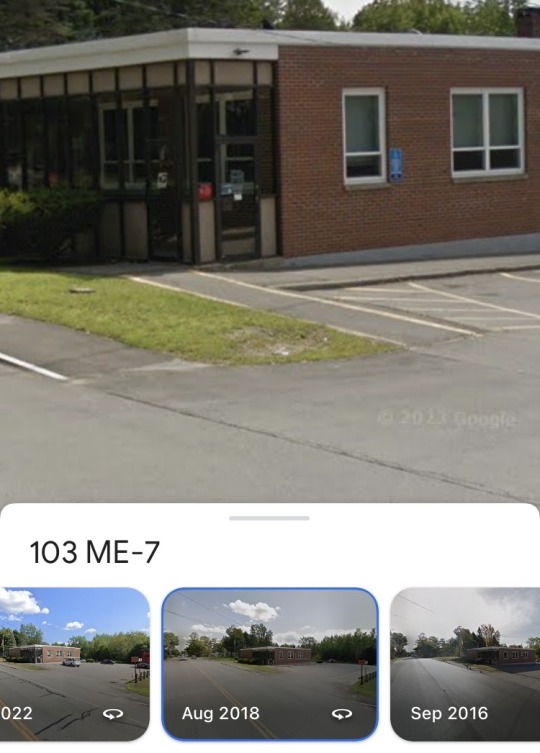
It’s hard to see from the Google Maps, but it was BAD. And it pissed me off. So I made a report. I got passed around from office to office for a few months, then nothing. 2020 comes around and the pandemic is hitting a high. I’ve moved towns and I’m dealing with a kind of shitty living situation that’s driven the ramp out of mind. I got a call one day from a man in one of the many offices the complaint was forwarded to. He is adamant that this ramp and door will be fixed. I mean, he assures me with passion that this will be fixed. At the time, I was really impressed and happy to hear something like that because I didn’t think anyone would still care while so much bad stuff was going on in the world.
And then I get mistreated and harassed by people based on my disabilities and gender. I become homeless because of it. I made an official complaint about discrimination, and the offenders lie through their teeth. The office handling my complaint says it didn’t happen, and closes the case. So I don’t exactly believe in these protections and offices that promise you’ll be helped so much anymore. I checked Google Maps one last time to see no changes sometime in 2021. It’s been a bitter, shitty feeling to hold on to for years now.
And then I checked my email just now.
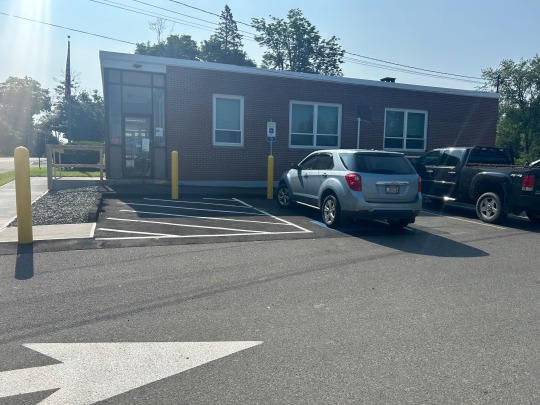
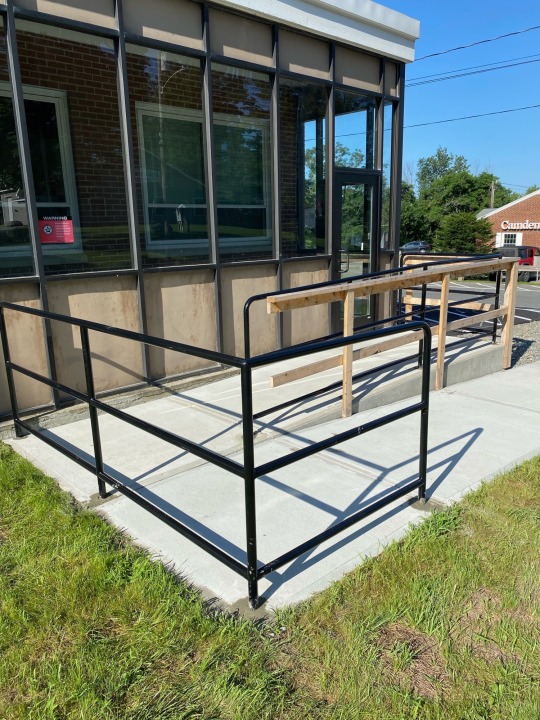
Ideally, they’d have added a door with an automatic opener, but they actually fixed everything else! They fixed it!
They fucking fixed it!
So, make those complaints. If a business or building is breaking the law by being inaccessible, fuck them up. Get your friend to report it, too. Maybe it will take four years, but maybe not. Maybe someone will genuinely care and actually fix it.
#ADA#accesability#disability#disability activism#disability accessability#I can’t fucking believe it#I really like after four years???#someone actually fucking cared and did the thing?
561 notes
·
View notes
Text








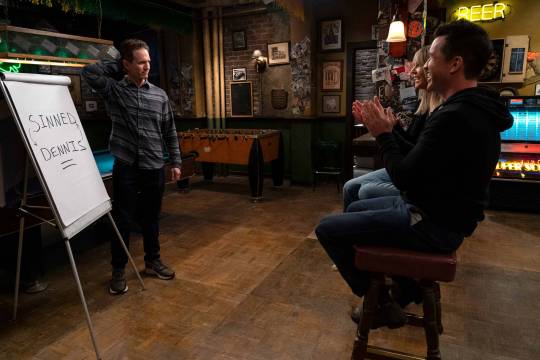
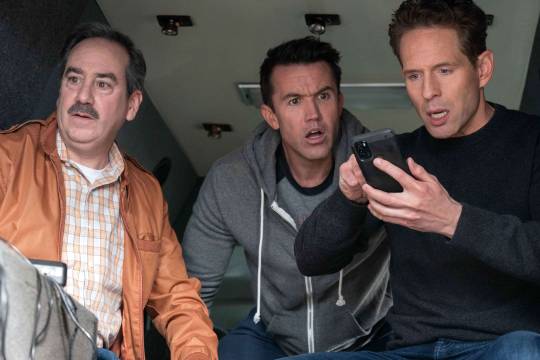






HQ Dennis Promo Stills from S16
#link back to my folder boy i paid for these to make sure everyone has access to them#iasip#it's always sunny in philadelphia#dennis reynolds#sunny sweet 16#ive been meaning to do this for a while but hadnt gotten around to it#more stills in the folder btw i just wanted to post the dennis ones <333#none for dtamhd which is SO fucking sad#ada speaks#iasip extras
17 notes
·
View notes
Text



C2E2 was so fun! I went from knowing almost nothing about Critical Role other than who Beau and Yasha were until @xaykwolf took me to the last live show at C2E2 in 2020 to getting to be second row at the show this year, cosplaying, meeting the cast (they are all amazing, and Taliesin, Matt, and Ashley were super kind), giving out little Pate stickers for other cosplayers (and hopefully every Laudna specifically!), and the overall vibe of most critters was amazing! Liam also called out my cosplay during the live show Q and A and I'll be riding that high for a while! I hope they do this again, and I can't wait to do this again for Indy's live show!
#Penguin's personal posts#I got a BUNCH of other signatures#But I would like to credit the artists I bought them from and I'm too tried to search for them right now#And shout out to the Molly cosplayer who helped me know what ADA stuff I could access because I was dying today#Next time I'll have more stickers for everyone ;;
10 notes
·
View notes
Text

That's the way to do it.
355 notes
·
View notes
Text

Haven’t seen anyone mention it on here but I thought I’d share just in case:
In the United States the Department of Energy(?) has released two (2) dockets stating their intent to remove the laws part of Section 504 of the ADA stating any and all new buildings constructed MUST be accessible and ADA compliant
Aka, if this goes, any new buildings DO NOT have to abide by ADA accessibility laws. This is obviously not cool or rad and will be implemented July 15th this year
SO if you have the time and energy to do so, please leave a comment on BOTH dockets linked. Emphasis on both because a lot of people are only doing one but it’s important both receive comments by June 16th!! This is being kept very quiet and on the low which has been very easy for them to accomplish with everyone’s attention on the protests, deportations, etc. (which is very important to pay attention to; but it’s no coincidence they’re making the move during this time)
Again, if you have the time and energy, a comment on BOTH links is massively cool and rad and if you don’t have the time or energy that is also cool and rad 🤙✨

#actually disabled#disability#disabled rights#disability rights#ADA#accessibility#fuck the government#uhh#no idea what else#anyway#yeah please comment if you can#this does not bode well#for anybody#so yknow#spread the word if you can 🤙
5 notes
·
View notes
Text
I do think colleges not being accessible is very funny because it is EXCLUSIVELY the administrations fault. I knew a frat guy in a wheelchair with a service dog and he was at every party like they made the pledges carry his chair up the stairs and included the dog on their composite.
29 notes
·
View notes
Text
ADA Accessibility
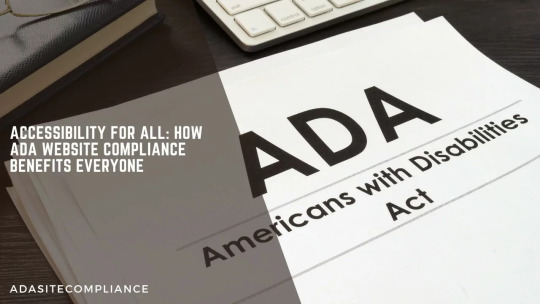
Accessibility For All: How ADA Website Compliance Benefits Everyone
Website design ensures user accessibility, prompting businesses to prioritize ADA compliance. Enacted in 1990, the Americans with Disabilities Act (ADA) marked a significant milestone in fostering inclusivity by addressing disability discrimination across various domains, including digital platforms.
With an estimated 61 million disabled individuals in the United States, ADA compliance assumes paramount importance in the contemporary digital landscape. Failure to achieve ADA accessibility translates to the denial of equal online content access for people with disabilities.
Consequently, businesses must ensure their websites cater to all users, irrespective of disability. However, navigating the intricate web of evolving web accessibility laws poses challenges for companies and organizations.
ADA Site Compliance offers comprehensive solutions, facilitating regulatory compliance. Equipped with a team of adept compliance professionals who track regulatory trends, businesses can ensure their websites meet requisite standards.
What exactly is web accessibility?
Web accessibility encompasses the deliberate planning and development of websites to ensure equitable access and usability for individuals with and without disabilities. By adhering to web accessibility standards, websites enable all users, irrespective of their abilities, to utilize and derive value from web-based services, content, and digital products.
10 Must-Know ADA Accessible Website Benefits
If you are unsure about ADA compliance, take a look at this: Here is a list of ten ways an ADA website benefits everyone:
1. Enhanced Audience Engagement
The integration of WCAG and ADA standards makes websites accessible for individuals with disabilities. By prioritizing adherence to these regulations, businesses engage with an estimated 61 million disabled Americans, thus extending their audience reach significantly.
This proactive initiative provides for broader audience reach, digital marketing, and wider audience engagement for enterprises while underscoring their dedication to fostering diversity and equal access to online resources.
2. Enhanced Search Engine Visibility
While the connection between ADA compliance and Search Engine Optimization (SEO) may not be immediately apparent, it is significant. ADA compliance, such as using alt text, aligns with SEO best practices.
Alt text enhances accessibility and helps search engines effectively understand and index page content. It thus improves the website’s visibility on search engine results pages (SERPs).
3. Optimized User Experience for Users with Screen Readers
An accessible design enhances the user journey, especially those using screen readers, to increase customer satisfaction, thus increasing conversion rates. Effective compliance strategies include:
Clear Information Architecture: Organize content logically to help users of assistive technologies navigate the site effectively.
Navigational Clues: Use breadcrumbs and other navigational aids to guide visitors seamlessly through the website.
Simplified Forms: Use descriptive labels and plain language to simplify form completion and increase conversion rates.
Streamlined Checkout Process: Minimizing the steps required for checkout facilitates faster transactions.
Clear Instructions and Links: Provide concise instructions and descriptive link text at each stage to enhance user understanding and engagement.
Extended Session Timeouts: Ensure that users with assistive technologies have sufficient time to complete tasks without interruptions. These strategies prioritize user satisfaction, engagement, conversion rates, and website performance.
4. Legal Protection
The Americans with Disabilities Act (ADA) mandates online accessibility, emphasizing its significance in ensuring equitable access. With a surge in lawsuits targeting non-compliant websites, adherence to ADA and Web Content Accessibility Guidelines (WCAG) standards offers legal protection, less legal risk, prevents expensive lawsuits, and guarantees user accessibility.
5. Enhanced Brand Image
In today’s socially conscious landscape, diversity and accessibility are not mere buzzwords but integral brand values. ADA-compliant websites signify a brand’s commitment to inclusivity and equal access. This proactive stance enhances brand reputation, fosters consumer goodwill and customer loyalty, and strengthens audience relations.
6. Fosters Creative Exploration
Incorporating more accessible web experiences and design principles demands a commitment to creativity and flexibility in response to evolving trends. Business leaders thus explore innovative solutions and continuously refine website designs to align with accessibility standards.
7. Enhanced Search Engine Optimization (SEO)
Accessible web design plays a vital role in improving SEO and fostering inclusivity. Adhering to WCAG standards by implementing alt-text for images, ensuring straightforward content, and adopting simplified page layouts significantly enhances website SEO.
Furthermore, accessible websites facilitate higher user engagement, reduce bounce rates, and elevate search engine rankings with search engine web crawlers. The website’s online presence and accessibility is further strengthened through additional SEO tactics such as:
Abstaining from using images for textual content
Providing video transcripts
Incorporating descriptive text alternatives for images, links, and buttons
8. Ethical Responsibility
Ensuring web accessibility is both a fundamental human right and an ethical duty. By prioritizing accessibility, you uphold principles of dignity, equality, and inclusivity for elderly individuals and those with disabilities.
9. Employee Retention
Accessible digital platforms empower disabled employees to access essential information, such as important resources like benefits and work schedules, fostering a supportive and inclusive work environment. This increases employee satisfaction and retention as individuals feel valued and accommodated within the organization.
10. Gives a Competitive Advantage
Embracing accessibility not only ensures compliance with regulatory mandates but also drives innovation. By addressing the unique needs of individuals with disabilities, organizations can develop innovative solutions that enhance the overall user experience.
This proactive stance distinguishes them as leaders in promoting inclusion while positioning them ahead of competitors in adopting user-centric design principles.
Web Content Accessibility Guidelines Determine Compliance
Developing an ADA-compliant website necessitates an ongoing process of thoroughly examining elements by web designers. Key considerations to enhance your website traffic usability and accessibility include:
Alternative text for images
Captions for videos
Transcripts for audio content, facilitating accessibility
Optimal color contrast, text size, and keyboard navigation
Assessing Website Accessibility
During the development or reconstruction of a website, it is essential to check accessibility from the outset and continuously throughout the process. Identifying accessibility issues early enables prompt rectification, simplifying the overall correction process.
While adjusting browser settings can reveal basic accessibility aspects, a comprehensive review to ensure compliance with all accessibility standards necessitates a more extensive examination.
While evaluation tools can aid the assessment process, they are not the sole determinant of a website’s accessibility status. Expert evaluation by knowledgeable individuals is indispensable for accurately gauging the accessibility of a website.
Conclusion
The prioritization of digital accessibility underscores proactive engagement with potential customers in the dynamic digital landscape, strategically positioning organizations for prosperity. This concerted effort ensures that all individuals can seamlessly engage with online platforms. Such commitment to accessibility fosters societal benefits by promoting digital equity.
Accessible websites transcend regulatory mandates, embodying the ethos of digital inclusivity. By rendering content, products, and services accessible to the diverse online community, businesses expand their customer base and outreach significantly.
Navigating the intricate web of web accessibility legislation can be challenging for businesses and organizations. ADA Site Compliance offers holistic solutions to ensure alignment with compliance regulations. Get your FREE WEBSITE SCAN today!
youtube
#ADA Website Compliance Benefits#ADA Compliance#ADA Accessibility#Americans with Disabilities Act (ADA)#Web Accessibility#ADA Website Benefits#Web Content Accessibility Guidelines (WCAG)#ADA Compliant Websites#Accessibility Standards#Accessible Websites#Digital Accessibility#Free Website Scan#ada site compliance#web accessibility#accessibility services#diversity and inclusion#ada guidelines#inclusive design#accessible website development#ada compliance solutions#web accessibility audit#digital accessibility#equitable web design#ada regulations#inclusive user experience#ada consulting#accessible content#ada accessibility#web design for disabilities#disability compliance
0 notes
Text
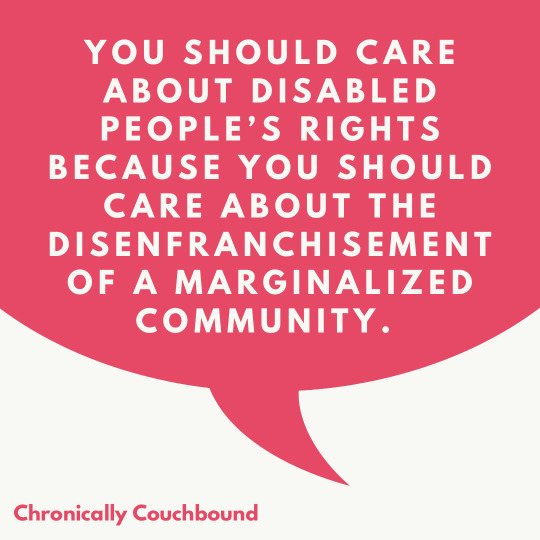
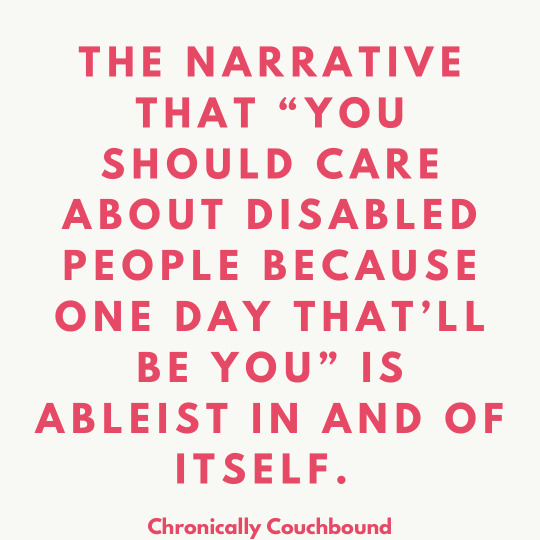
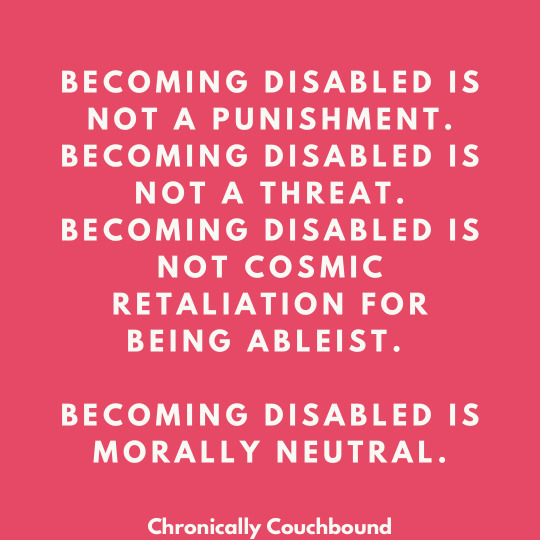
A dopamine-friendly version of this post for my fellow neurodivergent people who might need it!
•
[ID: three photos, all in a coral and white color scheme, text reads: “You should care about disabled people’s rights because you should care disenfranchisement of a marginalized community.” The next reads: “The narrative that you should care about disabled people because one day that’ll be you is ableist in and of itself” the last photo reads: “Becoming disabled is not a punishment. Becoming disabled is not a threat. Becoming disabled is not cosmic retaliation for being ableist. Becoming disabled is morally neutral” My blog name, ‘Chronically Couchbound’ is at the bottom of each photo. End ID]
#disability#chronically couchbound#disabled#disabled pride#disability pride#cripple punk#cripplepunk#not your inspiration#accessibility#disabled liberation#ableism#disabled rights#disability rights#I will not pander to my oppressors#disabled unity#disabled equity#ada#handicap accessible#wheelchair accessible#sensory friendly#dopamine friendly#sensory enriched posts
969 notes
·
View notes
Text
#polls#poll#daily polls#i love polls#polladay#disabilities#disability#disabled#accessibility#accessibility features#ada
5 notes
·
View notes
Text
The only valid thing Curtain ever did was smashing straight through doors that don't open fast enough for his wheelchair. Accessibility king
#if the venue is not accessible you should just barrel straight through the wall like the Kool-Aid man#AU where instead of going to prison after his capture Curtain becomes an ADA officer and uses his shouty grandpa powers#to yell at businesses that are not accessible until they fix it#and also to smash through their doorframe to prove a point#I think it would be good for him and it would benefit society#the mysterious benedict society#mr. curtain#ledroptha curtain
19 notes
·
View notes
Text
as a disabled person who uses a mobility aid, i am literally begging store owners, landlords, etc. to make sure their handicap doors are ACCESSIBLE AND ACTUALLY WORK
today, i got stuck not once, but TWICE. i went to cvs (i had not been to this particular one with my mobility aid before) and had difficulty entering, as the automatic door had been blocked by stairs. as a cane user, i was able to navigate them, but decided i would take a different route to exit (into a shopping mall). as i went out through the alternative entrance, i was met with two sets of doors with an accessible swing. i pressed the first button and got through just fine, but when i pressed the second on the inside… it did not work. i tried leaning against the door to see if my weight would be enough to budge it but it was not… i was left stuck between the two sets of doors (as the accessibility buttons only worked ONE WAY) until someone came to help me.
the second has been an on going problem. my apartment has a swinging door that has been working great for me…. except for the past week and a half. for some reason the door with the swing is broken and has yet to be repaired. this has left me STRUGGLING to get into my apartment. thankfully, when exiting, i’m able to move the door with my weight, but entering the building is so difficult, as i struggle to keep the door propped open while i move past it with my mobility aid. what makes things worse is when able-bodied people just STAND there and watch me struggle rather than help. it INFURIATES me to no end knowing they have the ability to hold the door and help me but actively choose not to.
i am actually begging. please, please, please advocate for more spaces to be accessible. and if the measures in places don’t work, fix them or advocate for fixing them. and finally, if you see a disabled person struggling DO NOT TURN A BLIND EYE! HELP THEM! if a door is falling on them or they cant find an accessible entrance/exit, use your able-bodied privilege to aid them.
(FOR CLARIFICATION, that does not mean coddle/baby us if we’re doing fine. we don’t need help if we’re moving down the street/existing. only when we’re actively struggling/working to navigate an able-bodied world)
#disabled#disability rights#disability#disability pride#disabilties#queer and disabled#cane#cane user#ada accessible#accessability#non accessible spaces#swinging doors#disability acceptance#disability accessibility#mobility aid#ablism#ableist bullshit#personal rant
52 notes
·
View notes